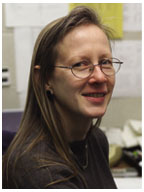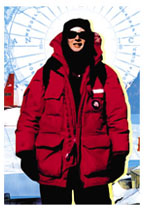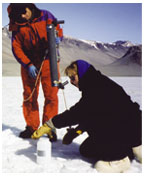April 23, 2003: Features

|
Biogeochemist Bess Ward seeks answers in Antarctica. (Ricardo Barros)
Bess Ward, in 1999, in a rock-collecting stop in the Wright Valley in East Antarctica. She and other scientists were looking for chemical signatures in the rocks that could provide information about differences between two Antarctic lakes.
Ward, right, and colleague John Priscu collect a water sample from ice-covered Lake Vanda in Antarctica, in 1992. The scientists drill a hole through the ice and lower a sampling bottle through the ice on a line. Lake Vanda water is used for comparisons with water from Lake Bonney. |
Going
to Xtremes
Professor
Bess Ward weathers Antarctica to solve scientific riddles
By Beth Livermore
Photos:
Few places on Earth are more bizarre than the Dry Valleys, in Antarctica. Here, on the eastern edge of the world’s iciest continent, where Captain Robert Scott met his fate battling the elements, is a polar desert full of buttes and canyons that rival those of the American Southwest. To stand here, among wind-carved ventifacts and mummified seals, is to know an alien world. In fact, NASA, which conducts experiments in surrounding sandscapes, calls it Earth’s nearest equivalent to Mars. But what lures geology professor Bess Ward here from her cozy digs in Guyot Hall for eight weeks at a time is not the superlative landscape, but more subtle chemical mysteries that lie beneath the icy cap of an Antarctic lake. Solving them, she believes, could lead to improved environmental management.
Ward, who joined Princeton’s faculty in 1998 and teaches oceanography, environmental microbiology, and environmental science, policy, and management, is no stranger to adventure. As an Alabama native, born to two professors, her first adventures were intellectual. “My mother knew I’d be a scientist because I was always asking questions,” Ward says. She left Auburn to study zoology at Michigan State University (“the farthest school from home,” Ward says), and then headed to the University of Washington, in Seattle, for a Ph.D. in biological oceanography – her ticket to world travel. From there, between research collaborations at places like the Max Planck Institut für Limnologie, in Plön, Germany, and Woods Hole Oceanographic Institution, in Massachusetts, she has led research cruises everywhere from the Monterey Bay to the South Pacific, and has assisted on dozens of others.
Still, Antarctica was a stretch at first. “I didn’t really want to go. It’s just too cold,” says Ward, who did her thesis research in the Gulf of Alaska without complaint. But soon after hearing about Lake Bonney in 1992, she realized she had no choice but to trade her sandals and al fresco lunch hours at University of California—Santa Cruz, where she chaired the marine science department, for a massive red parka, subzero temperatures, frozen peanut butter sandwiches, and hair-raising helicopter rides.
Lake Bonney, located inland from the Ross Sea, is an aquatic oddball. To start, it is one of eight lakes that form the only chain in the world to maintain year-round ice cover. Though modified over millions of years by glacial movement, the inflow of ocean waters, and relentless winds, the lakes have been ice-capped for at least 2,000 years. This fact alone has drawn scientists to Lake Bonney’s shores. In the 1980s, John Priscu, professor of biology at the University of Montana, discovered that water in one part of the lake had such fantastic levels of dissolved gases that it bubbled in his sample tubes. In fact, the water contains 5,800 times more nitrous oxide gas than the average bucket of seawater. That makes it the world’s highest recorded natural concentration of nitrous oxide. Priscu called Ward “to help him figure out what was going on,” she recalls.
“Bess brought a wealth of information from marine systems to the study of Lake Bonney,” Priscu says. “I have always seen the lakes in the Dry Valleys as models for oceanic processes, and her background was invaluable. And she’s a hard worker, always tackling problems that many would avoid owing to their difficulty.” Besides, he says, “she is as stubborn as all get out, which helps her get the job done.”
Ward is a biogeochemist, a scientist who studies the relationship between organisms and their chemical environment. Specifically, she studies ocean-dwelling bacteria called nitrifiers and denitrifiers, which make their living by either producing or breaking down nitrogen oxides. “People think of bacteria as germs,” Ward says. “But bacteria do everything: They make the atmosphere, they make soil, purify water, contaminate water. The rest of the biosphere does nothing compared to bacteria.” Her “bugs,” in particular, are believed to determine the chemical form and supply of nitrogen to plankton populations and the net nitrogen supply of ecosystems. In fact, denitrification is said to provide the planet’s most important sink of fixed nitrogen.
This is important because we humans continue to generate increasing amounts of nitrogen with our modern lifestyles. Some estimate that the amount of nitrogen that moves between land and sea has doubled in recent years, mostly because of nitrogen-based fertilizers, which either drain off agricultural lands into nearby coastal waters, or evaporate into the air and later rain down over the oceans. The global impact of this phenomenon is unclear, but algal blooms – or explosions – resulting from nitrogen poisoning already have caused red and brown tides off the coasts. Not only is this inconvenient to beachgoers, it kills plants, fish, and birds. In addition, the world’s oceans are a major source of nitrogen oxide, a potent greenhouse gas that contributes to ozone destruction. So understanding how specific seagoing bacteria, and the conditions in which they live, can increase or decrease this output could prove important to Earth’s future.
But understanding this is no simple task. The world’s oceans are vast and turbulent, which makes asking complicated questions difficult, at best. Imagine the havoc that currents alone might wreak on a highly sensitive chemistry experiment. This is why Ward knows little about the three sites she has identified with high nitrogen output from the ocean to the atmosphere. It is also why Lake Bonney is so valuable to her. “A lake is like a bottle compared to an ocean,” Ward says. It is multitudes easier to study – and to manipulate. Her eventual understanding of this simple system, or what switches the bacteria on and off in its depths, could shed light on similar oceanic anomalies, as well as the inner workings of the nitrogen cycle. This in turn could lead to better environmental management.
So, in 1992, Ward overcame her aversion to Antarctica, and the hardships of working there, and made her first two-month trip to the bottom of the world. It turns out that Lake Bonney was everything she had hoped for, yielding a host of rich findings. So she made three more trips in 1994, 1999, and 2000, but never without trepidation.
Life on ice
J ust getting to Antarctica is taxing. The trip starts off with a 14-hour flight to Auckland, followed by an hour-long hop to Christchurch, New Zealand, where immediately upon arrival, visitors are shuttled to a supply house for “E.C.W.,” or extreme cold-weather gear, including several layers of long underwear, hats, gloves, goggles, boots, and the big red parka that punctuates every National Geographic photo from the South Pole. Then, with duffle bags in hand, they’re rushed onto an LC-130 cargo plane with canvas slings for seats, and they strap themselves in for a nine-hour flight in which the highlights are frozen bologna sandwiches and rare bursts of hot air. There is no bathroom, even though the travelers are encouraged to drink as much water as possible to stave off dehydration. Instead, a bucket sits at the ready behind a tower of boxed hamburger, paper towels, test tubes, and whatever other supplies are being delivered that day.
Finally, the enormous plane, the size of a B-52, lands on a snow-covered airstrip in the middle of a plateau, which is vacant but for a few Quonset huts, trailer homes, and what look like extras from M*A*S*H. Stepping out into the bitter cold, new arrivals are either blinded by a snow squall when the weather is bad, or brilliant white light reflecting off ice, snow, and sky when it’s good. Either way, visitors inevitably reach for their glacier glasses, an essential piece of survival gear, and board a Snow Cat that trudges up over a rise to McMurdo Station.
McMurdo Station, located on McMurdo Sound, is the largest base on the continent. It serves as control center and catchment area – where everything originates and concludes. It feels a lot like a frontier town must have felt in the early days of America’s history. This is where you can find a medic, a decent meal, and a warm bed. But instead of a gin mill, there’s a coffee house. Instead of gunslingers, there are bush pilots. Instead of Pony Express, there’s e-mail. And, instead of gold diggers there are “beakers,” or scientists, who study everything from ice flow rates, to penguin fertility, to neutrino activity. In fact, the McMurdo population swells from about 150 permanent staff members to more than 1,000 people during research season, November through February — Antarctica’s summertime, when the sun shines 24 hours a day. For the past two trips, Ward and her team, which included Karen Cosciotti *02 and research assistant Julie Granger, have bunked there in dormitories, flying by helicopter to Lake Bonney to work 12- to 14-hour days. “Each time I fly, I wonder if it’s going to be my last trip,” she says. The air is so clear that the mountains seem just feet from the window. “It’s pretty exciting.” Ward is not surprised that some pilots who shuttle scientists also fly IMAX film crews.
The first two seasons, Ward flew into Lake Bonney with Priscu and their team and made camp on the sandy shoreline. It didn’t take long to realize why nothing but bacteria lives there. Outside team members’ North Face tents, where the scientists spent days at a time fighting illness, winds whirled at up to 27 miles per hour, while temperatures plummeted to minus 50 degrees Fahrenheit. Daily survival required the constant application of moisturizers to cracked hands and lips, and snacking to renew energy lost to staying warm and moving around in cumbersome gear. Not all luxuries had to be sacrificed: One Thanksgiving, for example, the helicopter pilots flew out to the lake with a turkey and vegetables — called “freshies” — from the base, and the scientists had a real holiday dinner. From that, Ward made what Priscu calls “the best turkey soup I ever had in Antarctica, or anywhere else.” Still, simple needs like finding water posed major challenges. For a drink, for example, they had to chip ice from the lake’s edge and melt it, or drill a hole and fish it up. “It can be kind of gritty,” Ward says. “McMurdo is easier. Much warmer.” Either way, collecting samples poses similar challenges.
On her Guyot Hall computer screen, Ward pulls up an image of a small blue tent amidst the rubbled surface of Lake Bonney. Inside the tent, there’s a hole that measures a meter in diameter and four meters deep, made with a Jiffy power drill and chipped free of ice each morning. “The trick is trying not to drop the chipper down the hole,” Ward says. “Everybody does it at least once.” Ward explains how the scientists ease a 40-meter-long Teflon hose down through the hole to a set depth, marked on the tube in meters. Once in place, they flip on the attached peristaltic pump and siphon water out of the lake into a sanitized hood, or “clean box” with filtered air. There, gloved hands guide the water into sterilized 10-liter foil pouches, to assure no additional metals from the environment are introduced to the samples.
From there, samples are carefully loaded into casket-sized coolers and flown back to McMurdo by helicopter. A small amount is frozen and sent stateside by air or cargo ship, along with a season’s worth of trash and urine barrels. But most of it goes to a McMurdo lab room, kept at 12 degrees Celsius, where Ward and her team work around the clock for days at a time. The race is on; the further removed the samples are from the time of collection, the less reliable the data. Often exhausted, Ward takes her sleep when she can, despite the eternal sun. And though the McMurdo chow is legendary, she has never gained an ounce. In fact, she lost 10 pounds last time around. “That was a bonus.”
The biggest pay off, however, were of course the research findings.
Fishing for answers
he first thing Ward and her team found was that the lake has plenty of bacteria. The numbers of bacteria are not dramatically different from those in any other lake or ocean, Ward says. They vary between 10,000 and a million cells per milliliter – the range you would see in the ocean. But denitrifying bacteria, which can break down nitrate in the absence of oxygen, don’t seem to be doing their jobs. So she next asked what makes them so sluggish, especially in the eastern section, where they do almost nothing. The cold, dark conditions of the Antarctic clearly account for some share of the slowdown. After all, it’s dark for six months of the year. But that’s not the whole story. Ward points her finger at lake water chemistry – more specifically, at the concentration of bioactive trace metals. Denitrifying bacteria need bioactive trace metals, like copper and iron, to catalyze the process. Perhaps too much or too little would shut them down, Ward speculates. To find out, “We monkeyed with the water chemistry,” she says.
Back in the Guyot lab, they tested what the scarcity of copper could do to these bacteria, using synthetic ocean water – which they used to control the conditions of the experiment and because they could not lug enough Lake Bonney water back to Princeton – and several strains of denitrifying bacteria. Reducing the amount of copper appeared both to slow down the work rate of these species and their growth — that is, cell division. This, in turn, caused nitrogen oxides, either nitrite or nitrous oxide, to accumulate in the medium. Then the scientists reversed the equation, adding copper to similar cultures. Sure enough, they saw both a resumption of growth and consumption of nitrous oxide. These observations suggest a role for trace metals in regulating both the breakdown and production of nitrogen in the ocean.
But is this what happens in Lake Bonney?
To find out, Ward cast a larger net, conducting a slew of similar manipulations, with an increased variety of substances on cultures made with real Lake Bonney water and bacteria. But she was soon surprised. “Nothing worked,” Ward says. In fact, none of the treatments, whether they added or subtracted substances, seemed to elicit a significant effect on the lake’s natural microbial community. So they failed to identify the trigger. But not all was lost. In fact, Ward continues to maintain a variation of her original metals hypothesis.
That’s because new evidence from chemical analysis of Lake Bonney water has identified a possible new suspect. Silver and iron were the only metals measured that had dramatic differences in distribution between the two sections of the lake. The iron concentrations don’t concern the scientists; though it was 200 times lower in the east section, the iron there still was enough to allow normal functioning. Silver, on the other hand, could pose a major problem for the lake. First, the silver concentrations were up to 150-fold higher in the east than in the west. That’s significant. And silver “is an absolutely useless biological metal,” Ward says. “It does nothing except poison everything. It’s used as a water purifier – it kills things.” It may also block the denitrifying process.
So now, despite the cold and hard work, Ward hopes to return to Antarctica in November to investigate the potential role of silver in the slowdown, among other potential factors. She also has requested grant funding to study a patch of water in the Arabian Sea, which, like Lake Bonney, has high nitrous oxide, despite plenty of denitrifying bacteria. “There’s not very much copper [there],” she explains. “If . . . [the bacteria] can’t get enough copper, they can’t do their thing – and nitrous oxide accumulates. So we’re hypothesizing that availability of copper might control denitrification in the ocean. And we got that idea from the experiments that we did in this lake.”
That means Ward’s preliminary work on Lake Bonney has already yielded
intellectual gold – or silver, as it may be. ![]()
Beth Livermore is a prize-winning freelance writer who specializes in science and travel.



